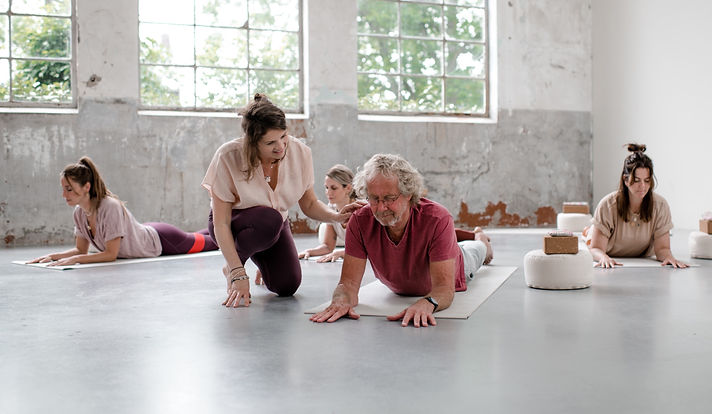
Corporate Yoga
Yoga means connection [1]. Connection of body and mind, by combining physical postures, breathing exercises, mindfulness and meditation.
So you get more control over body and mind by practicing yoga. And more specifically you will learn:
explore & broaden the physical limits of your body;
recognize the (stress) signals of your body and actively relax; and
observe your thoughts, which often calms your mind and makes you less reactive.
Rest and relaxation
Startup Yoga focuses on the quiet, relaxed forms of yoga [2]. After all, working life is already intensive and dynamic enough. In addition, tension and excitement [3] are often used to 'clear' the head, while the necessary rest and physical relaxation is lacking. Startup Yoga contributes to restoring the balance.
Yoga focused on rest & relaxation
Yoga has its roots in ancient India, more than 2000 years ago [3]. In the last hundred years, many different yoga styles have emerged, from intensive & dynamic [4] to rest & relaxation.
The corporate yoga classes focus on Yin Yoga or Chair Yoga, but Restorative Yoga and/or Yoga Nidra are of course also possible. Would you like to know more about the different yoga styles and what suits you best in the workplace? Let's connect!
[1] Sanskrit is the oldest living Indo-European language and the sacred written language for Buddhism and Hinduism, among others. All the classical scriptures on yoga are also written in Sanskrit.
[2] Yin Yoga , Restorative Yoga , Yoga Nidra & Stoelyog a .
[ 3 ] Tension and excitement are often used to 'clear' the head, such as 'binging' an exciting Netflix series or an intensive HITT training. Nothing wrong with that in itself, except that you don't really let your body relax during such activities.
For example, by watching a series you take in a lot of stimuli and during an intensive training you increase your breathing and heart rate and you create adrenaline. This turns on the sympathetic part of your autonomic nervous system. The part that focuses on survival (think of fighting, fleeing and performing (under stress)).
True relaxation turns on the parasympathetic part of your autonomic nervous system. The part that focuses on rest and recovery. Yoga focuses on "turning on" this parasympathetic part, which makes you better able to withstand stress, sleep better, your brain works better (better memory), regulate emotions better, improve your immune system and you are better able to socialize. Interaction.
[4] The purpose of the physical yoga poses was to keep the body strong, powerful and balanced. The yoga postures served as preparation for the sitting meditation, so that you can sit in silence for longer. The poses are therefore only a small part of yoga philosophy. The core of yoga philosophy lies in raising consciousness and connection with the divine.
[5] Including Hatha, Ashtanga & Vinyasa flow yoga styles.
[6] In case of pregnancy or physical complaints and injuries, please let me know so that this can be taken into account in class.















